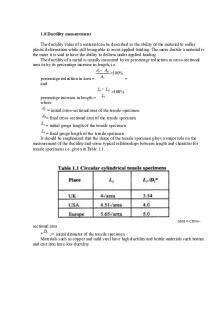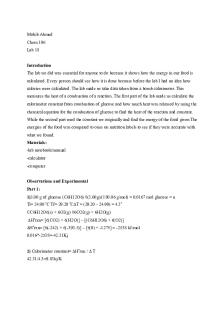1.8 Ductility measurement PDF

| Title | 1.8 Ductility measurement |
|---|---|
| Author | DIGVIJAY SINGH CHAUHAN |
| Course | Mathematical Methods For Materials Scientists And Engineers |
| Institution | Massachusetts Institute of Technology |
| Pages | 1 |
| File Size | 96.9 KB |
| File Type | |
| Total Downloads | 68 |
| Total Views | 123 |
Summary
notes...
Description
1.8 Ductility measurement The ductility value of a material can be described as the ability of the material to suffer plastic deformation while still being able to resist applied loading. The more ductile a material is the more it is said to have the ability to deform under applied loading. The ductility of a metal is usually measured by its percentage reduction in cross-sectional area or by its percentage increase in length, i.e. AI AF 100% A I percentage reduction in area = = and LI LF 100% L I percentage increase in length = where AI = initial cross-sectional area of the tensile specimen AF = final cross-sectional area of the tensile specimen
LI = initial gauge length of the tensile specimen LF = final gauge length of the tensile specimen It should be emphasized that the shape of the tensile specimen plays a major role on the measurement of the ductility and some typical relationships between length and character for tensile specimens i.e. given in Table 1.1.
area = crosssectional area D * I ,= initial diameter of the tensile specimen Materials such as copper and mild steel have high ductility and brittle materials such bronze and cast iron have low ductility...
Similar Free PDFs

1.8 Ductility measurement
- 1 Pages

Measurement Assignment
- 6 Pages

Porosity Measurement
- 6 Pages

Measurement lab report 2
- 2 Pages

Measurement of Crime
- 3 Pages

3. Measurement - Topic summaries
- 7 Pages

2.1 measurement steps
- 2 Pages

Assignment - Measurement of VO2max
- 16 Pages

18 - lab 18
- 4 Pages

18 - Lecture notes 18
- 5 Pages

TEMA 18 - Apuntes 18
- 3 Pages
Popular Institutions
- Tinajero National High School - Annex
- Politeknik Caltex Riau
- Yokohama City University
- SGT University
- University of Al-Qadisiyah
- Divine Word College of Vigan
- Techniek College Rotterdam
- Universidade de Santiago
- Universiti Teknologi MARA Cawangan Johor Kampus Pasir Gudang
- Poltekkes Kemenkes Yogyakarta
- Baguio City National High School
- Colegio san marcos
- preparatoria uno
- Centro de Bachillerato Tecnológico Industrial y de Servicios No. 107
- Dalian Maritime University
- Quang Trung Secondary School
- Colegio Tecnológico en Informática
- Corporación Regional de Educación Superior
- Grupo CEDVA
- Dar Al Uloom University
- Centro de Estudios Preuniversitarios de la Universidad Nacional de Ingeniería
- 上智大学
- Aakash International School, Nuna Majara
- San Felipe Neri Catholic School
- Kang Chiao International School - New Taipei City
- Misamis Occidental National High School
- Institución Educativa Escuela Normal Juan Ladrilleros
- Kolehiyo ng Pantukan
- Batanes State College
- Instituto Continental
- Sekolah Menengah Kejuruan Kesehatan Kaltara (Tarakan)
- Colegio de La Inmaculada Concepcion - Cebu




